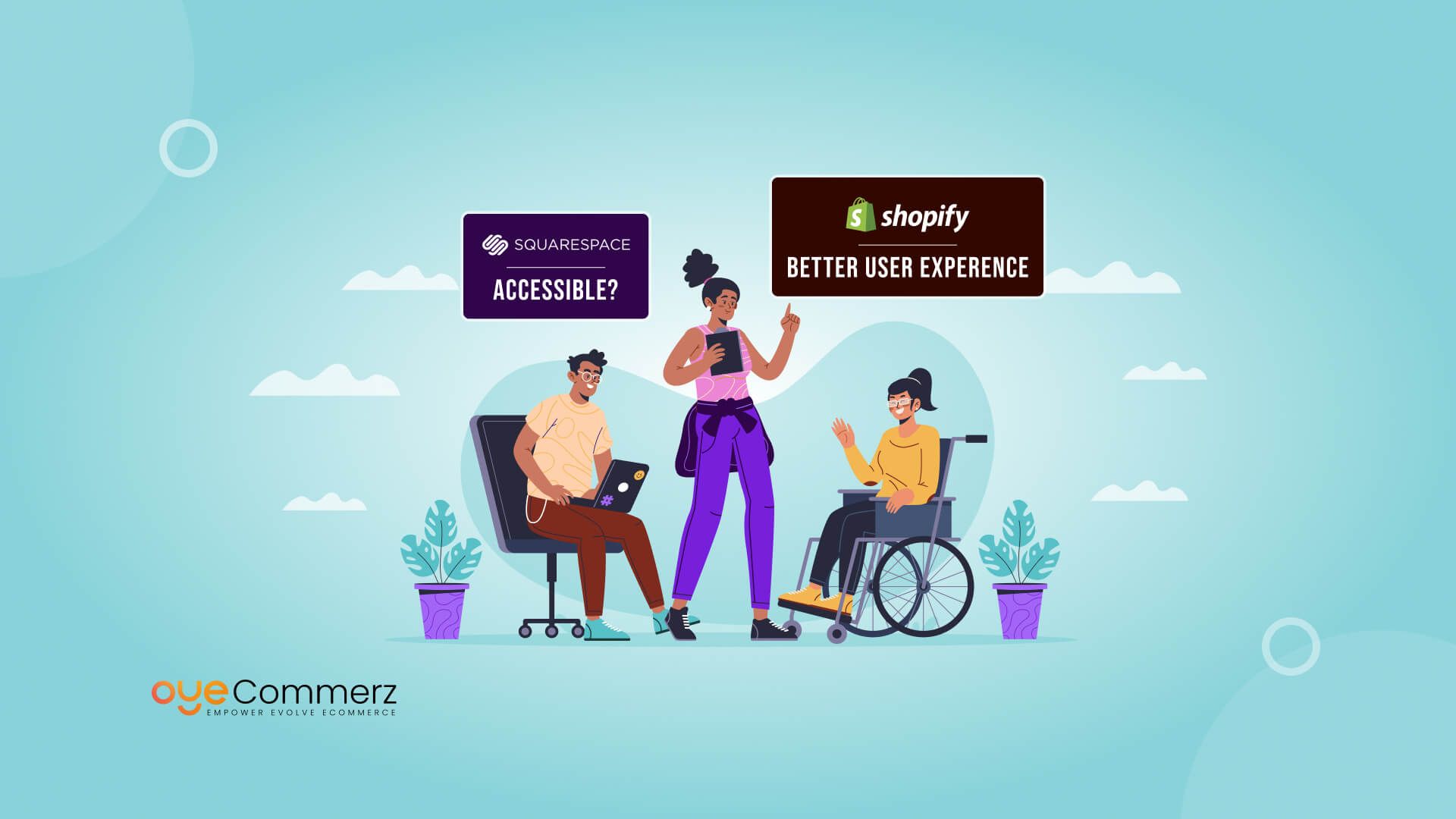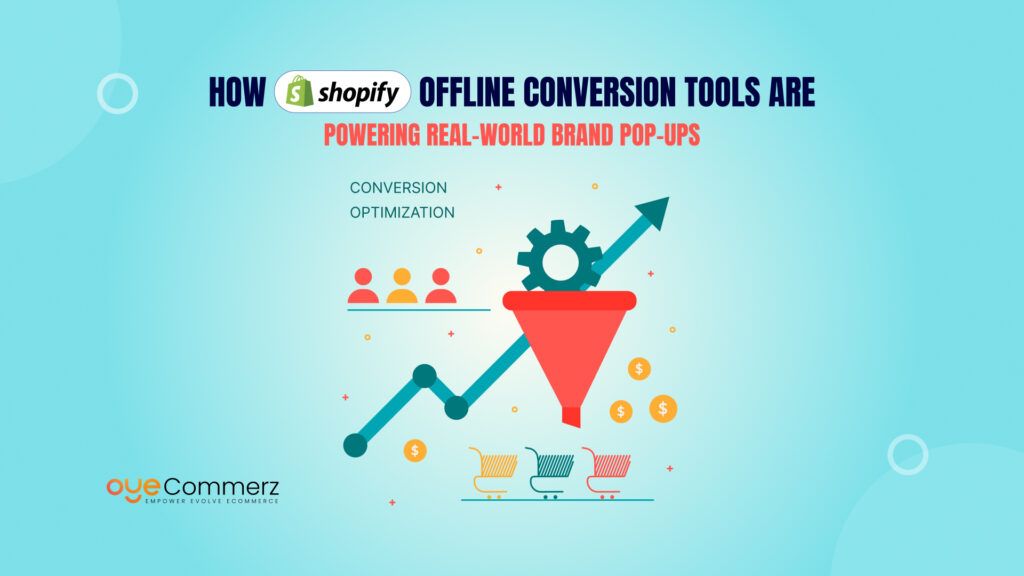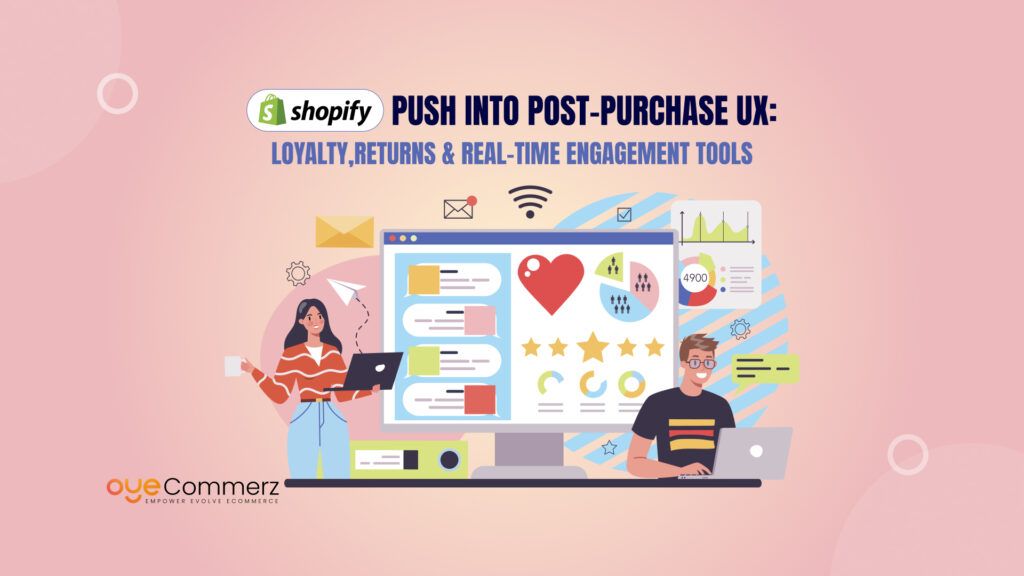“Wondering if Squarespace accessible, meets all your website accessibility and user experience needs?” Many businesses choose Squarespace for its sleek design and drag-and-drop convenience. However, as their websites grow, they encounter limitations that affect accessibility and overall user experience. Accessibility is essential for ensuring that websites are usable by everyone, including people with disabilities, and poor accessibility can lead to lost customers, legal issues, and damaged reputations.
This blog explores whether Squarespace delivers a seamless experience for all users or falls short in meeting critical accessibility standards. We’ll also examine how Shopify addresses these challenges, providing better tools and features to enhance accessibility and user satisfaction. By comparing the pros and cons of both platforms, we aim to help you determine which platform aligns best with your business goals and customer needs. Let’s dive deeper into the importance of web accessibility and see how these platforms measure up.
Table of Contents
ToggleUnderstanding Website Accessibility: Why It Matters
What is Website Accessibility?
Website accessibility ensures that digital platforms are usable by everyone, including people with visual, auditory, cognitive, and motor impairments. It involves designing and developing websites so that all users, regardless of ability, can easily navigate and interact with content. The Web Content Accessibility Guidelines (WCAG) set the global standard for making websites accessible, while the Americans with Disabilities Act (ADA) mandates that websites comply with accessibility laws in the United States.
Impact of Poor Accessibility
When websites lack proper accessibility features, they alienate a significant portion of potential users. Differently-abled individuals may struggle to navigate websites that are not optimized for screen readers, lack keyboard navigation, or have poor color contrast. Beyond ethical concerns, poor accessibility can negatively impact search engine rankings, making websites less discoverable. Additionally, businesses risk facing legal action and potential financial penalties for non-compliance with accessibility laws, leading to reputational damage.
Why Modern Websites Need Accessibility
Accessible websites expand the customer base by ensuring inclusivity and providing a seamless user experience for all. Compliance with accessibility standards not only reduces legal risks but also strengthens brand trust and credibility. In today’s digital age, prioritizing accessibility is essential for maintaining a competitive and inclusive online presence.
Accessibility Challenges with Squarespace
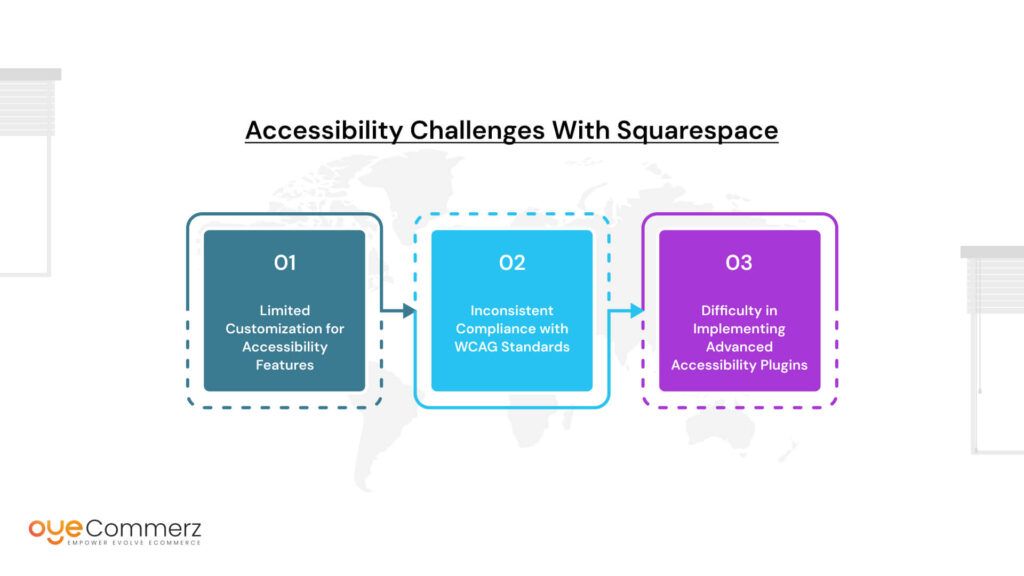
Limited Customization for Accessibility Features
Squarespace’s design flexibility is visually impressive but falls short when it comes to ensuring accessibility. Unlike platforms that allow developers to modify HTML and CSS freely, Squarespace restricts the level of control needed to integrate ARIA (Accessible Rich Internet Applications) labels, alt tags, and other vital elements that improve accessibility. Since these features are essential for screen readers and assistive technologies, the inability to implement them effectively makes Squarespace a less inclusive platform, raising concerns about whether Squarespace accessible for all users.
Additionally, Squarespace’s templates do not offer sufficient flexibility to modify the layout and structure required for enhancing accessibility. For visually impaired users who rely on screen readers, a lack of semantic HTML and poorly labeled elements can significantly hinder navigation. Without the ability to customize key elements, merchants face limitations in creating a truly accessible website.
Inconsistent Compliance with WCAG Standards
Although Squarespace claims to provide accessible templates, many of its designs fall short of full compliance with WCAG (Web Content Accessibility Guidelines) standards. While the platform includes some basic accessibility features, such as alt text for images, it lacks the depth required to ensure compliance across all web pages.
For example, a small business that migrated its website from Squarespace to a more customizable platform reported a significant drop in bounce rates and an increase in user engagement after improving its site’s accessibility. They discovered that their previous Squarespace site was missing crucial ARIA landmarks, making it difficult for users with screen readers to navigate. This case illustrates how Squarespace’s limited compliance can impact both user experience and SEO performance.
Difficulty in Implementing Advanced Accessibility Plugins
Squarespace’s plugin ecosystem is relatively limited, making it difficult for store owners to integrate advanced accessibility features. Platforms like Shopify offer a wide range of apps to enhance accessibility, whereas Squarespace users have fewer options to choose from. This limitation restricts the ability of businesses to improve their site’s usability and ensure a seamless experience for all users.
Key Limitations:
- Lack of robust third-party plugins for accessibility.
- Inability to add essential features like real-time text resizing or keyboard navigation assistance.
Why Shopify Excels in Accessibility and User Experience
Built-In Accessibility Features
Shopify has established itself as a leader in creating accessible eCommerce platforms by incorporating features that comply with WCAG (Web Content Accessibility Guidelines) standards. Most Shopify themes are designed with built-in alt text for images, ARIA landmarks for easier navigation, and optimized keyboard navigation to ensure a seamless experience for all users. These features reduce the need for complex manual adjustments, making Shopify a more inclusive platform for businesses looking to enhance their website’s accessibility.
Furthermore, Shopify’s attention to detail in creating an inclusive experience extends to its mobile-responsive themes. As mobile commerce continues to grow, ensuring accessibility across devices is crucial. Shopify’s themes automatically adjust to different screen sizes while maintaining usability for visually impaired users and those relying on assistive technologies.
Advanced Customization with Liquid
One of Shopify’s biggest advantages is its use of Liquid, a flexible and powerful templating language that allows deep customization of web pages. With Liquid, developers can modify and fine-tune site elements to meet accessibility standards. This includes adding ARIA roles, restructuring HTML for better semantic understanding, and ensuring dynamic content remains accessible to all users.
Unlike Squarespace, which limits control over HTML and CSS, Shopify’s Liquid gives complete freedom to integrate features that enhance usability. Developers can customize forms, product pages, and checkout processes to ensure seamless experiences for differently-abled users.
Third-Party Apps and Plugins for Accessibility
Shopify’s App Store offers a wide array of apps designed to improve accessibility. Apps like AccessiBe and UserWay help businesses optimize their sites to meet compliance requirements and enhance user experiences. These tools provide real-time text adjustments, color contrast options, and screen reader compatibility, all without requiring technical expertise.
Additionally, Shopify supports the easy integration of chatbots and virtual assistants that can assist differently-abled users in navigating the site. These tools not only improve the overall user experience but also contribute to higher conversion rates by making the site more inclusive.
Top Accessibility Apps Available on Shopify:
- AccessiBe: Automates accessibility adjustments and compliance checks.
- UserWay: Provides a widget for real-time content adjustments.
- EqualWeb: Offers a variety of AI-powered accessibility features.
By offering built-in features, deep customization, and a thriving ecosystem of accessibility apps, Shopify ensures that businesses can create a platform that caters to every user, regardless of their abilities.
Comparison Table: Ease of Use – Squarespace vs. Shopify
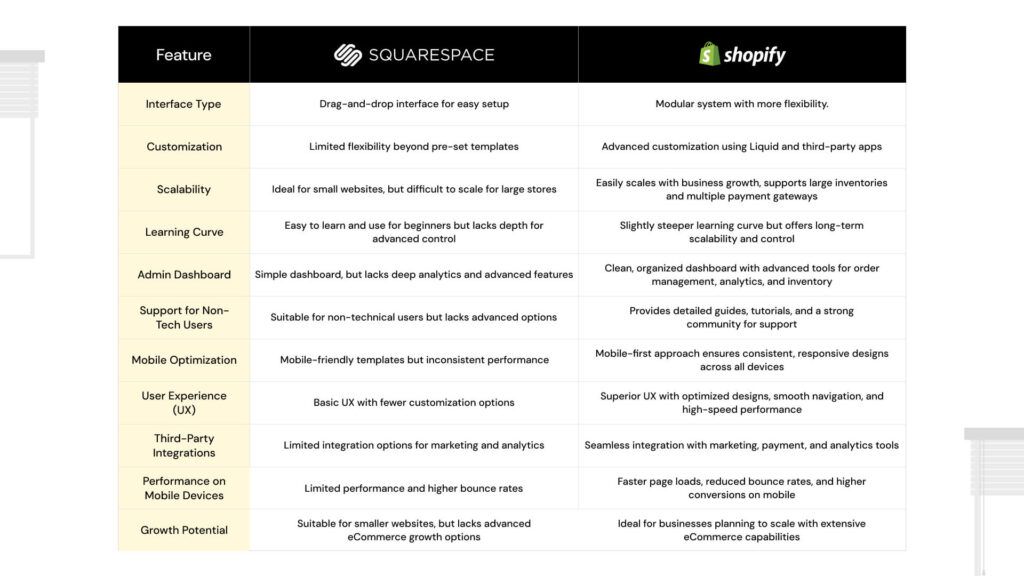
Key Takeaways:
- Squarespace: Best for beginners looking for an easy-to-use, visually appealing platform but lacks advanced customization and scalability.
- Shopify: Provides a more robust, flexible, and scalable solution with superior UX and extensive integration options, making it ideal for growing businesses.
Shopify’s ease of use, flexibility, and superior mobile optimization make it the better choice for long-term eCommerce success, especially when compared to the limitations of Squarespace accessible features.
SEO and Marketing Capabilities: Shopify’s Edge
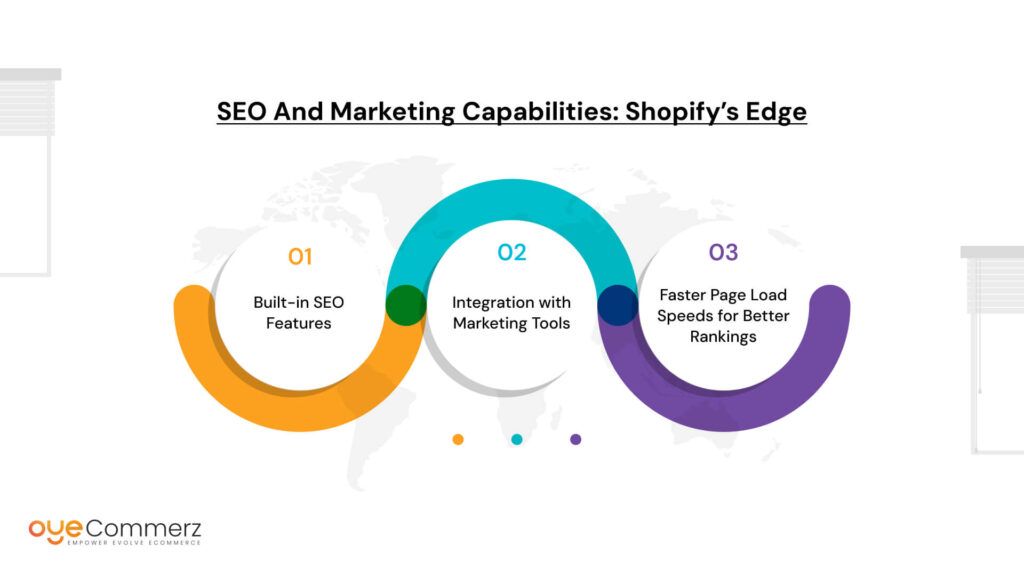
Built-in SEO Feature
Shopify excels in SEO by offering built-in tools that enhance search engine visibility. Its clean URL structures, automatic generation of meta tags, and alt attributes for images make it easier for search engines to crawl and index web pages. These features contribute to higher rankings and better visibility, giving businesses a competitive edge in organic search. In contrast, Squarespace provides basic SEO functionality but lacks the advanced controls needed to optimize content effectively. Its limited flexibility in modifying on-page SEO elements often leads to poor search rankings, which can restrict growth potential.
Integration with Marketing Tools
Effective digital marketing requires seamless integration with analytical and promotional tools. Shopify supports direct integration with powerful marketing platforms such as Google Analytics, Facebook Pixel, and Mailchimp. These integrations allow business owners to track visitor behavior, create personalized campaigns, and automate email marketing with ease.
Advantages of Shopify’s Marketing Integrations:
- Real-time performance tracking and detailed analytics.
- Better audience targeting through Facebook Pixel and Google Ads.
- Automation of email campaigns and promotions via Mailchimp.
Squarespace, however, offers limited integrations, restricting its ability to leverage data-driven marketing strategies. This lack of flexibility makes it difficult for businesses to scale their marketing efforts effectively.
Faster Page Load Speeds for Better Rankings
Page load speed is a critical factor in both SEO and user experience. Shopify’s server infrastructure is optimized to deliver faster page loads, reducing bounce rates and improving overall site performance. Faster websites not only retain visitors longer but also rank higher on search engines.
Key Benefits of Shopify’s Fast Page Load Times:
- Lower bounce rates, leading to improved conversion rates.
- Higher search engine rankings due to faster page loads.
- Better mobile experience, enhancing customer satisfaction.
In contrast, Squarespace’s sites often lag behind in performance, resulting in slower load times that impact both SEO and user retention. As a result, businesses on Squarespace may struggle to maintain competitive rankings in search results, highlighting the limitations of Squarespace accessible SEO features.
Scalability and Growth Potential
Seamless Expansion with Shopify
Shopify is designed to grow with your business, making it an ideal platform for businesses of all sizes. It offers multiple pricing plans that allow users to upgrade as their business scales. Whether you are managing a small store or operating a high-volume enterprise, Shopify provides the flexibility to add new features and expand your operations. Additionally, Shopify supports multichannel selling, enabling businesses to sell on platforms like Amazon, eBay, and social media.
Advantages of Scaling with Shopify:
- Support for high-traffic websites without compromising speed.
- Easy management of product variations and complex inventory.
- Seamless integration with third-party marketplaces.
Challenges in Scaling with Squarespace
Squarespace is well-suited for small businesses but falls short when it comes to managing large-scale operations. Its infrastructure lacks the flexibility required to handle high traffic volumes and complex inventory management. For growing businesses, Squarespace’s inability to support advanced product catalogs and diverse payment gateways can become a significant limitation, making Squarespace accessible scalability a challenge for expanding enterprises.
Limitations of Scaling on Squarespace:
- Difficulty managing high-volume inventory.
- Limited options for integrating with external sales channels.
- Lack of advanced automation for managing large-scale operations.
Shopify Plus for Enterprise-Level Growth
For businesses experiencing rapid growth, Shopify Plus offers a dedicated enterprise solution. It includes advanced features such as automation, API integrations, and enterprise-grade security. Shopify Plus empowers large-scale businesses to streamline operations while maintaining high performance.
Key Benefits of Shopify Plus:
- Custom automation for order management and fulfillment.
- Advanced API capabilities to integrate with external systems.
- Robust security features for enterprise-level protection.
Shopify’s ability to adapt to the evolving needs of growing businesses makes it a superior choice for brands aiming for long-term success.
App Ecosystem and Customization Options
Shopify App Store: A Competitive Advantage
Shopify’s App Store offers over 6,000 apps designed to enhance functionality and improve business performance. These apps cover various aspects of eCommerce, including SEO, dropshipping, inventory management, and customer retention. This extensive ecosystem empowers store owners to customize their websites to meet their unique needs without requiring advanced technical expertise.
Popular Categories of Shopify Apps:
- SEO optimization to improve search rankings.
- Dropshipping apps to automate product sourcing.
- Order management and fulfillment solutions.
Limited Plugin Options in Squarespace
Squarespace’s app ecosystem is relatively limited, offering fewer options for enhancing website functionality. This limitation makes it difficult for business owners to integrate advanced features and automate processes. While Squarespace does provide some essential plugins, it lacks the variety and sophistication that Shopify’s App Store offers.
Challenges with Squarespace’s Limited Plugin Options:
- Restricted ability to integrate advanced marketing and SEO tools.
- Difficulty in automating order management and customer interactions.
- Limited options for enhancing overall site functionality.
How a Business Benefited from Shopify’s App Ecosystem
Let’s say there is a mid-sized fashion retailer switched from Squarespace to Shopify to take advantage of its extensive app ecosystem. After the migration, the retailer integrated apps for order management and automated marketing campaigns, leading to a 25% increase in customer retention and a 15% boost in sales within six months. This transition highlights the tangible benefits of leveraging Shopify’s app marketplace to optimize business operations.
Shopify’s wide range of apps and customization options make it an ideal platform for businesses looking to enhance functionality and automate processes.
Design Flexibility and Theme Variety
Wide Range of Themes in Shopify
Shopify offers a diverse collection of over 100 free and premium themes, designed to cater to various industries and business types. These themes are fully customizable and mobile-optimized, ensuring a seamless shopping experience across devices. Shopify themes are built with HTML, CSS, and Liquid, giving developers the flexibility to modify the design and functionality of the site to meet business requirements.
Advantages of Shopify Themes:
- Mobile-responsive designs that enhance user experience.
- Ability to modify code for custom designs.
- Pre-built themes optimized for SEO and performance.
Squarespace’s Template Limitations
Squarespace is known for its visually appealing templates that are easy to use for beginners. However, these templates come with limited flexibility, making it challenging to modify the design beyond the pre-set layout. For businesses looking to create a highly customized and dynamic eCommerce experience, Squarespace’s limitations can hinder long-term growth.
Challenges of Using Squarespace Templates:
- Difficulty in modifying template structures.
- Limited customization options for advanced functionality.
- Restrictions in integrating complex design elements.
Why Shopify’s Design Flexibility is Superior
Shopify’s themes not only provide aesthetic appeal but also ensure functionality that meets the needs of growing businesses. The ability to customize themes with Liquid and add advanced features gives Shopify a significant advantage over Squarespace.
For businesses seeking a platform that offers both design flexibility and advanced functionality, Shopify remains the preferred choice.
Security and Compliance: Shopify Takes the Lead
PCI Compliance and Data Security
Security is a top priority in eCommerce, and Shopify sets a high standard by ensuring PCI-DSS (Payment Card Industry Data Security Standard) Level 1 compliance for all its stores. This certification guarantees that Shopify protects sensitive credit card information by maintaining the highest security protocols. Every transaction processed through Shopify is encrypted, minimizing the risk of data breaches and ensuring customer data remains safe.
In addition to PCI compliance, Shopify provides built-in SSL (Secure Sockets Layer) certificates for all stores, safeguarding data transferred between users and the website. SSL encryption adds another layer of security by ensuring that information, such as login credentials and payment details, is protected from cyber threats. This level of security builds trust with customers and ensures compliance with global data protection regulations.
Key Security Features of Shopify:
- PCI-DSS Level 1 certified for secure transactions.
- Built-in SSL certificates for encrypted data transfer.
- Automatic updates to address security vulnerabilities.
Squarespace’s Security Concerns
Squarespace, while offering basic security features, falls short when it comes to PCI compliance. Since Squarespace is not PCI-certified, businesses that handle large volumes of online transactions may face regulatory challenges and increased liability. This lack of compliance makes Squarespace less suitable for growing eCommerce stores that require secure payment processing.
Moreover, Squarespace’s limited control over backend security introduces potential vulnerabilities that could expose websites to cyberattacks. Unlike Shopify, which provides robust security measures and regular updates, Squarespace does not offer the same level of protection, leaving businesses at a higher risk of data breaches.
Challenges with Squarespace Security:
- No PCI compliance, increasing security risks for payment processing.
- Limited backend control for addressing security threats.
- Potential vulnerabilities due to insufficient security protocols.
For businesses prioritizing secure transactions and regulatory compliance, Shopify’s advanced security framework makes it a more reliable choice. With its robust infrastructure and dedication to data protection, Shopify ensures that eCommerce websites remain safe from potential security threats.
Customer Support and Community
24/7 Customer Support by Shopify
Shopify stands out in the eCommerce space by offering 24/7 customer support through multiple channels, including live chat, email, and phone. This round-the-clock support ensures that store owners can get assistance whenever they encounter technical issues, regardless of their time zone. Whether it’s troubleshooting a payment gateway error or resolving a design glitch, Shopify’s support team provides prompt and reliable solutions.
Beyond direct support, Shopify offers extensive documentation, tutorials, and an active community forum where users can find answers to common questions. These resources empower store owners to troubleshoot minor issues independently and enhance their understanding of the platform.
Key Benefits of Shopify’s Customer Support:
- 24/7 availability through chat, email, and phone.
- Comprehensive knowledge base and tutorials.
- Active community forums with experienced developers and merchants.
Limited Support Options in Squarespace
Squarespace offers customer support through live chat and email but does not provide phone support, which can be a significant limitation for store owners requiring immediate assistance. While live chat is available during specific hours, email responses may take longer, leaving users without quick solutions during critical times.
Additionally, Squarespace lacks a robust community forum where users can exchange knowledge and find answers to platform-specific challenges. Without an active peer-to-peer support network, Squarespace users often face delays in resolving technical problems and limited opportunities for learning from experienced developers.
Challenges with Squarespace’s Support System:
- No phone support, limiting immediate assistance options.
- Live chat available only during certain hours.
- Lack of a vibrant community for peer-to-peer problem-solving.
For businesses seeking reliable, 24/7 customer support and a strong community network, Shopify’s customer service infrastructure offers far greater value and efficiency.
Ready to take your online store to the next level?
Explore Shopify’s powerful features today with Oyecommerz and unlock new growth opportunities for your business. Start your migration now and future-proof your eCommerce journey!
Contact us now!
Contact to Migrate your Site to Shopify Now
Conclusion
Shopify clearly outperforms Squarespace in critical areas such as accessibility, scalability, SEO, and customization. With its built-in SEO tools, advanced security features, and an extensive app ecosystem, Shopify empowers businesses to create a more engaging and seamless shopping experience. Additionally, Shopify’s intuitive interface, mobile-first design, and 24/7 customer support make it a reliable platform for businesses of all sizes. For those concerned about Squarespace accessible limitations, Shopify offers a more inclusive and optimized solution.
For entrepreneurs looking to scale their business while ensuring a secure, optimized, and user-friendly experience, Shopify offers unmatched flexibility and growth potential. Migrating to Shopify allows businesses to leverage superior features and build a successful eCommerce presence.

